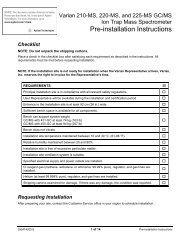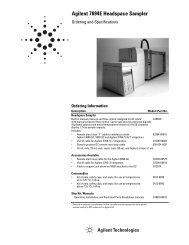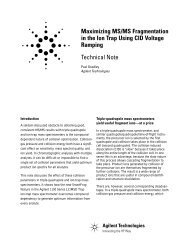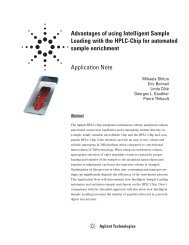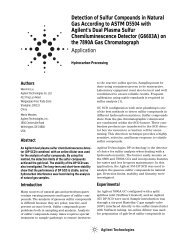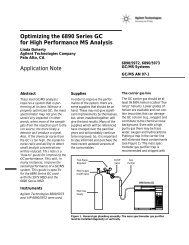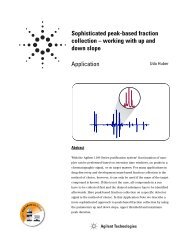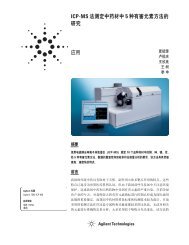Specific Determination of Bromate and Iodate in Ozonized Water by ...
Specific Determination of Bromate and Iodate in Ozonized Water by ...
Specific Determination of Bromate and Iodate in Ozonized Water by ...
Create successful ePaper yourself
Turn your PDF publications into a flip-book with our unique Google optimized e-Paper software.
<strong>Specific</strong> <strong>Determ<strong>in</strong>ation</strong> <strong>of</strong> <strong>Bromate</strong><br />
<strong>and</strong> <strong>Iodate</strong> <strong>in</strong> <strong>Ozonized</strong> <strong>Water</strong> <strong>by</strong> Ion<br />
Chromatography with Two Detection<br />
Methods : Postcolumn Derivatization<br />
<strong>and</strong> ICP-MS Detection<br />
Submitted to : Journal <strong>of</strong> Chromatography A, 789, 259-265 (1997)<br />
Application Note<br />
Environmental<br />
Michiko Yamanaka<br />
Abstract<br />
A specific determ<strong>in</strong>ation for bromate, iodate <strong>and</strong> other halogen anions<br />
<strong>in</strong> dr<strong>in</strong>k<strong>in</strong>g water <strong>by</strong> direct <strong>in</strong>jection us<strong>in</strong>g ion chromatography (IC)<br />
with either <strong>in</strong>ductively coupled plasma mass spectrometry (ICP/MS), or<br />
the postcolumn derivatization is described. The advantages <strong>of</strong> ICP/MS<br />
as an element selective detector was evaluated for bromate <strong>and</strong> iodate<br />
<strong>by</strong> consider<strong>in</strong>g the comparison with the postcolumn derivatization.<br />
Samples were directly <strong>in</strong>jected <strong>in</strong>to the IC column, <strong>and</strong> halogen anions<br />
were separated. The eluates were directly <strong>in</strong>troduced <strong>in</strong>to ICP/MS <strong>and</strong><br />
detected at 79 <strong>and</strong> 127 amu. The detection limit (S/N = 3) for bromate<br />
<strong>and</strong> iodate with <strong>in</strong>jection <strong>of</strong> 0.5 mL were 0.45 µg Br/L <strong>and</strong> 0.034 µg I/L,<br />
respectively. The IC comb<strong>in</strong>ed with ICP/MS was applied to the<br />
simultaneous determ<strong>in</strong>ation <strong>of</strong> bromate, bromide <strong>and</strong> other halogen<br />
anions <strong>in</strong> raw <strong>and</strong> ozonized water. Good agreement was obta<strong>in</strong>ed for<br />
the determ<strong>in</strong>ed values <strong>by</strong> IC-ICP/MS <strong>and</strong> postcolumn derivatization.<br />
Furthermore, several brom<strong>in</strong>e species different from bromate or<br />
bromide were detected <strong>by</strong> IC-ICP/MS.<br />
Agilent Technologies<br />
Innovat<strong>in</strong>g the HP Way<br />
1
Introduction<br />
<strong>Bromate</strong> can be formed <strong>by</strong> the<br />
oxidation <strong>of</strong> bromide ions dur<strong>in</strong>g<br />
ozonation <strong>and</strong> possibly <strong>by</strong> other<br />
oxidants <strong>in</strong> water treatment [1-4].<br />
<strong>Bromate</strong> has been estimated as a<br />
potential carc<strong>in</strong>ogen, <strong>and</strong> has<br />
been classified <strong>in</strong> Group 2B <strong>by</strong><br />
the International Agency <strong>of</strong><br />
Research on Cancer (IARC).<br />
The concentration <strong>of</strong> bromate <strong>in</strong><br />
dr<strong>in</strong>k<strong>in</strong>g water associated with an<br />
excess lifetime cancer risk <strong>of</strong> 10 -5<br />
corresponds to 3 µg/L [5]. The<br />
World Health Organization (WHO)<br />
recommended the provisional<br />
guidel<strong>in</strong>e value <strong>of</strong> 25 µg/L which is<br />
associated with an excess lifetime<br />
cancer risk <strong>of</strong> 7 x 10 -5 , because <strong>of</strong><br />
limitation <strong>in</strong> available analytical<br />
<strong>and</strong> treatment methods [5].<br />
Ion chromatography (IC) with a<br />
pretreatment method [6] or an<br />
on-l<strong>in</strong>e preconcentration method<br />
[7-8] has been reported for the<br />
determ<strong>in</strong>ation <strong>of</strong> trace bromate.<br />
However, the peak <strong>of</strong> bromate at<br />
the detection limit level will <strong>of</strong>ten<br />
vanish <strong>in</strong> that <strong>of</strong> chloride which is<br />
always present <strong>in</strong> water at a level<br />
<strong>of</strong> three orders <strong>of</strong> magnitude higher.<br />
The authors have developed a<br />
sensitive <strong>and</strong> selective ion<br />
chromatographic determ<strong>in</strong>ation<br />
method <strong>of</strong> bromate with<br />
postcolumn conversion <strong>in</strong>to<br />
tribromide <strong>by</strong> hydrobromic<br />
acid [9]. Sub-µg/L <strong>of</strong> bromate <strong>in</strong><br />
water was determ<strong>in</strong>ed <strong>by</strong> us<strong>in</strong>g<br />
the developed postcolumn<br />
derivatization. Furthermore, other<br />
dis<strong>in</strong>fectant <strong>by</strong>-products such as<br />
chlorite <strong>and</strong> iodate were also<br />
detected with similar detection<br />
limits.<br />
On the other h<strong>and</strong>, <strong>in</strong>ductively<br />
coupled plasma mass spectrometry<br />
(ICP/MS) comb<strong>in</strong>ed with liquid<br />
chromatography or IC (LC-ICP/MS<br />
or IC-ICP/MS) is an effective<br />
technique for the speciation study<br />
<strong>of</strong> metallic <strong>and</strong> organometallic<br />
species because <strong>of</strong> its element<br />
selectivity <strong>and</strong> sensitivity. The<br />
comb<strong>in</strong>ed technique has been also<br />
applied to the determ<strong>in</strong>ation <strong>of</strong><br />
halogen species, especially, iod<strong>in</strong>e<br />
that can be sensitively detected <strong>by</strong><br />
ICP/MS [10-14].<br />
In the present work, the specific<br />
determ<strong>in</strong>ation <strong>of</strong> bromate, iodate<br />
<strong>and</strong> other halogen species <strong>in</strong><br />
dr<strong>in</strong>k<strong>in</strong>g water <strong>by</strong> direct <strong>in</strong>jection<br />
us<strong>in</strong>g IC with ICP/MS <strong>and</strong> the<br />
postcolumn derivatization is<br />
described. The advantages <strong>of</strong><br />
ICP/MS as an element selective<br />
detector was evaluated for bromate<br />
<strong>and</strong> iodate <strong>by</strong> consider<strong>in</strong>g the<br />
comparison with the postcolumn<br />
derivatization. Furthermore, the<br />
IC-ICP/MS system was applied to<br />
the simultaneous determ<strong>in</strong>ation<br />
<strong>of</strong> halogen anions <strong>in</strong> raw <strong>and</strong><br />
ozonized water.<br />
Experimental<br />
Reagents<br />
All reagents used were purchased<br />
from Wako Pure Chemical<br />
Industries (Osaka, Japan). Stock<br />
solutions (1000 mg/L as elements)<br />
for each anion were prepared <strong>by</strong><br />
dissolv<strong>in</strong>g with pure water <strong>and</strong><br />
stored <strong>in</strong> refrigerator. Analytical<br />
solutions were prepared <strong>by</strong><br />
dilut<strong>in</strong>g the stock solution to<br />
the required concentration just<br />
before use. Pure water was<br />
obta<strong>in</strong>ed from Milli-Q system<br />
(Nihon Millipore, Tokyo, Japan).<br />
Instrument<br />
Ion chromatograph used <strong>in</strong> this<br />
experiment was Model IC7000S<br />
(Yokogawa Analytical Systems<br />
Inc., Japan) equipped with a<br />
UV/VIS detector, <strong>and</strong> ICP/MS was<br />
Model 4500 (Agilent Technologies,<br />
Inc. USA). Excelpak ICS-A23 <strong>and</strong><br />
ICS-A13 (7.6 mm x 4.6 mm i.d.<br />
each, Yokogawa Analytical<br />
Systems Inc.) were chosen as<br />
separation columns. ICS-A23<br />
<strong>and</strong> ICS-A13 were packed with<br />
hydrophilic <strong>and</strong> semi-hydrophilic<br />
anion exchange res<strong>in</strong> with<br />
0.05 mequiv./g <strong>of</strong> dry, respectively.<br />
IC-ICP/MS<br />
Ion chromatograph <strong>and</strong><br />
ICP/MS were connected <strong>by</strong><br />
500 mm x 0.3 mm i.d. <strong>of</strong> ETFE<br />
tube. Ammonium carbonate was<br />
chosen as a mobile phase.<br />
Ammonium salt was used to<br />
prevent a salt deposition <strong>and</strong><br />
clogg<strong>in</strong>g at sampl<strong>in</strong>g orifice <strong>of</strong><br />
ICP/MS caused <strong>by</strong> sodium <strong>in</strong> a<br />
mobile phase. The operat<strong>in</strong>g<br />
conditions <strong>of</strong> ICP/MS are<br />
described <strong>in</strong> Table 1.<br />
Postcolumn derivatization<br />
Two Excelpak ICS-A13 columns <strong>in</strong><br />
series were chosen to separate the<br />
halogen species accord<strong>in</strong>g to the<br />
previous paper [9]. The operat<strong>in</strong>g<br />
conditions <strong>of</strong> the postcolumn<br />
derivatization are described <strong>in</strong><br />
Table 2.<br />
Results <strong>and</strong> Discussion<br />
Separation <strong>of</strong> halogen anion<br />
First <strong>of</strong> all, the separation <strong>of</strong><br />
halogen anions us<strong>in</strong>g ICS-A13 as<br />
the separation column accord<strong>in</strong>g<br />
to previous paper [9] was<br />
exam<strong>in</strong>ed to establish appropriate<br />
separation conditions. The<br />
chromatography behaviour <strong>of</strong><br />
iodide on anion-exchange res<strong>in</strong>s<br />
has been described [15]. In this<br />
experiment, however, the peak <strong>of</strong><br />
iodide showed a broad <strong>and</strong> tail<strong>in</strong>g<br />
shape, while bromate, bromide<br />
<strong>and</strong> iodate showed good peak<br />
shapes. It was also noted that the<br />
retention time was long (more<br />
than 30 m<strong>in</strong>) <strong>and</strong> depended on its<br />
concentration. It was not drastically<br />
improved <strong>in</strong> spite <strong>of</strong> a series<br />
<strong>of</strong> change <strong>of</strong> mobile phase.<br />
2
-<br />
RF power<br />
RF reflected power<br />
Plasma gas<br />
Auxiliary gas<br />
Carrier gas flow<br />
Sampl<strong>in</strong>g depth<br />
Mass<br />
Integration time<br />
Number <strong>of</strong> scans 1<br />
Table 1<br />
Operational conditions <strong>of</strong> ICP-MS.<br />
Ion Chromatography<br />
1300 W<br />
a) BrO 3 -<br />
15<br />
y = 6.3702x -0.5158<br />
RSD / %<br />
10<br />
5<br />
0<br />
R 2 = 0.6307<br />
0 5 10 15 20 25<br />
concentration / µg/L<br />
b) IO 3 - 15<br />
y = 1.5814x -0.6177<br />
RSD / %<br />
10<br />
5<br />
0<br />
R 2 = 0.9492<br />
0 0 .5 1 1 .5 2 2 .5<br />
concentration / µg/L<br />
Fig. 2<br />
Relationships between the RSD <strong>and</strong> sample concentration for bromate a) <strong>and</strong> iodate b).<br />
Experimental conditions are same as those given <strong>in</strong> Fig. 1.<br />
RSD values which were calculated<br />
for each set <strong>of</strong> 10 measurements<br />
<strong>of</strong> bromate <strong>and</strong> iodate solutions<br />
at various concentrations.<br />
Fig. 2 shows the relationships<br />
between the RSD <strong>and</strong> the sample<br />
concentration. The concentrations<br />
<strong>of</strong> bromate <strong>and</strong> iodate at 10 % <strong>of</strong><br />
RSD were 0.42 µg/L <strong>and</strong> 0.051 µg/L,<br />
respectively. Fig. 2 also shows the<br />
signal stability <strong>in</strong> the concentrations<br />
which give sufficient sensitivity<br />
for bromate <strong>and</strong> iodate.<br />
In both species, RSDs were<br />
saturated around 1% even <strong>in</strong> high<br />
concentrations. The saturated<br />
RSD is considered to be affected<br />
<strong>by</strong> ICP-MS stability.<br />
Interference <strong>by</strong> coexistent substance<br />
The <strong>in</strong>terference from coexistent<br />
substances such as chloride,<br />
sulfate <strong>and</strong> nitrate has been<br />
reported <strong>by</strong> Creed <strong>and</strong> others[14].<br />
They reported that bromate can<br />
be determ<strong>in</strong>ed <strong>in</strong> a chloride matrix<br />
with 5-6 orders <strong>of</strong> magnitude<br />
higher. However, a retention time<br />
shift for bromate <strong>in</strong> 1000 mg/L <strong>of</strong><br />
chloride matrix was observed. So,<br />
the <strong>in</strong>terference from coexistent<br />
substances such fluoride, chloride,<br />
nitrite, phosphate <strong>and</strong> sulfate was<br />
exam<strong>in</strong>ed. Mixed anion st<strong>and</strong>ard<br />
solutions rang<strong>in</strong>g <strong>in</strong> concentration<br />
from 5 to 50 mg/L <strong>of</strong> anions<br />
were <strong>in</strong>jected. Peaks <strong>of</strong> these<br />
anions were not observed on the<br />
chromatogram. The retention time<br />
shift for halogen anions <strong>in</strong> the<br />
concentration below 50 mg/L <strong>of</strong><br />
anions matrix was not observed.<br />
However, one peak was observed<br />
at void volume <strong>in</strong> chromatogram<br />
<strong>of</strong> 79 amu. This peak was<br />
recognized to be a polyatomic ion<br />
( 40 Ar 39 K+) formed <strong>by</strong> comb<strong>in</strong>ation<br />
<strong>of</strong> potassium <strong>in</strong> sample solution<br />
with argon as the plasma gas,<br />
because it appeared at the<br />
retention time <strong>of</strong> potassium<br />
that was observed <strong>in</strong> 39 amu.<br />
Conclusively, this peak due to<br />
potassium will be neglected on the<br />
determ<strong>in</strong>ation <strong>of</strong> bromate because<br />
it is eluted at the void volume <strong>of</strong><br />
the anion exchange column <strong>and</strong><br />
completely separated from that <strong>of</strong><br />
bromate under these separation<br />
conditions.<br />
Application to the determ<strong>in</strong>ation <strong>of</strong><br />
halogen anions <strong>in</strong> the water<br />
The presented method was<br />
applied to the determ<strong>in</strong>ation <strong>of</strong><br />
halogen anions <strong>in</strong> several water<br />
samples. The chromatograms <strong>of</strong><br />
the ozonized water <strong>by</strong> us<strong>in</strong>g<br />
IC-ICP/MS <strong>and</strong> the postcolumn<br />
derivatization were shown <strong>in</strong> Fig. 3.<br />
The determ<strong>in</strong>ed concentrations<br />
<strong>of</strong> halogen anions <strong>in</strong> raw (river)<br />
<strong>and</strong> ozonized water are listed <strong>in</strong><br />
Table 3. The concentrations <strong>of</strong><br />
halogen anions determ<strong>in</strong>ed <strong>by</strong><br />
both method were relatively <strong>in</strong><br />
agreement. However, some iodate<br />
values obta<strong>in</strong>ed us<strong>in</strong>g ICP-MS<br />
were slightly higher than that <strong>of</strong><br />
postcolumn derivatization. The<br />
disagreement could be due to<br />
lack <strong>of</strong> precision <strong>in</strong> such low<br />
concentration. Furthermore,<br />
there could be <strong>in</strong>terference from<br />
other iod<strong>in</strong>e-conta<strong>in</strong><strong>in</strong>g species<br />
coelut<strong>in</strong>g with iodate, because<br />
ICP-MS would detect any species<br />
conta<strong>in</strong><strong>in</strong>g iod<strong>in</strong>e, <strong>and</strong> it would<br />
give positive error <strong>in</strong> the iodate<br />
values. <strong>Bromate</strong> values <strong>by</strong> ICP-MS<br />
were a little lower than that <strong>of</strong><br />
postcolumn method. The reason is<br />
4
-<br />
50 00<br />
-<br />
a) ICP/MS<br />
ICP-MS signal / counts<br />
25 00<br />
0 2 .5 5 7 .5 10<br />
10 000 127 : I<br />
50 00<br />
79 : Br<br />
ArK +<br />
BrO 3<br />
Br -<br />
0 2 .5 5 7 .5 10<br />
b) postcolum n deriv atizat ion<br />
ab sorban ce / m AU<br />
4<br />
3<br />
2<br />
1<br />
0<br />
IO 3 -<br />
BrO 3 -<br />
retention time / m<strong>in</strong><br />
0 2 4 6 8 10 1 2 14<br />
retention time / m<strong>in</strong><br />
Fig. 3<br />
Chromatograms <strong>of</strong> ozonized water (sample B) us<strong>in</strong>g IC-ICP/MS a) <strong>and</strong> postcolumn derivatization b).<br />
Peaks: a) BO 3<br />
(13.0 µg/L), Br (17.8 µg/L), IO 3<br />
(3.57 µg/L), <strong>and</strong> I (3.56 µg/L) b) IO 3<br />
(4.13 µg/L), BO 3<br />
(15.7 µg/L)<br />
Experimental conditions are same as those given <strong>in</strong> Fig. 1 <strong>and</strong> Table 2. Unit <strong>of</strong> the concentrations<br />
is µg/L as species.<br />
determ<strong>in</strong>ed concentrations [µg/L as species]<br />
IC–ICP–MS<br />
postcolumn<br />
samples BrO<br />
-<br />
3<br />
Br - IO<br />
-<br />
3<br />
I - BrO<br />
- -<br />
3<br />
IO 3<br />
A. raw water 0.26 28.9 0.44 0.63 0.29 0.09<br />
B. ozonized sample A 13.0 17.8 3.57 3.56 15.7 4.13<br />
C. raw water 1.64 59.1 1.26 2.97 1.65 0.60<br />
D. ozonized sample C 1.88 38.5 5.66 0.14 2.31 4.98<br />
E. ozonized water 1.87 5.73 5.45 0.05 1.85 4.77<br />
Table 3<br />
Comparison <strong>of</strong> determ<strong>in</strong>ed concentrations <strong>of</strong> halogen anions <strong>in</strong> raw <strong>and</strong> ozonized water.<br />
Experimental conditions are same as those given <strong>in</strong> Fig. 1 <strong>and</strong> Table 2.<br />
I - IO 3<br />
16<br />
not clear because bromate<br />
values <strong>in</strong> this postcolumn reaction<br />
procedure doesn’t suffer from<br />
<strong>in</strong>terference from other oxidants [9].<br />
<strong>Bromate</strong> <strong>and</strong> iodate with the<br />
concentration <strong>of</strong> µg/L level were<br />
detected even <strong>in</strong> the raw water.<br />
Probably, the contam<strong>in</strong>ation <strong>of</strong><br />
river water with trace bromate<br />
was caused <strong>by</strong> a waste water.<br />
On the other h<strong>and</strong>, the existence<br />
<strong>of</strong> iodate <strong>in</strong> m<strong>in</strong>eral water has<br />
been also reported [17]. The<br />
concentrations <strong>of</strong> bromate <strong>and</strong><br />
iodate <strong>in</strong> the ozonized water were<br />
rather <strong>in</strong>creased than those <strong>in</strong> the<br />
correspond<strong>in</strong>g raw water, while<br />
that <strong>of</strong> bromide was decreased <strong>by</strong><br />
ozonation. Apparently, bromate<br />
<strong>and</strong> iodate will be formed dur<strong>in</strong>g<br />
ozonation for the water treatment.<br />
However, the material balances<br />
<strong>of</strong> brom<strong>in</strong>e <strong>and</strong> iod<strong>in</strong>e were<br />
absolutely <strong>in</strong>compatible. These<br />
results suggest the halo-oxyacids<br />
are produced <strong>by</strong> oxidation <strong>of</strong> the<br />
correspond<strong>in</strong>g halides, but that<br />
they are not always produced <strong>by</strong><br />
the same mechanism.<br />
Sample E gave a dist<strong>in</strong>ctive<br />
chromatogram at 79 amu (Fig. 4).<br />
Several unidentified species<br />
different from bromate or bromide<br />
were detected. These species are<br />
estimated as brom<strong>in</strong>e compounds<br />
because no <strong>in</strong>terferences from<br />
other elements are observed at<br />
79 amu. The existence <strong>of</strong> other<br />
brom<strong>in</strong>e species suggests that<br />
these species could lead to<br />
bromate dur<strong>in</strong>g ozonation. It<br />
can also expla<strong>in</strong> that the sum <strong>of</strong><br />
bromate <strong>and</strong> bromide was not<br />
constant for ozonized water <strong>and</strong><br />
its raw water (sample D <strong>and</strong> C) <strong>in</strong><br />
Table 3. Furthermore, a large<br />
unidentified peak with a broad<br />
peak shape was also detected<br />
at the retention time <strong>of</strong> about<br />
40 m<strong>in</strong>utes <strong>in</strong> the chromatograms<br />
<strong>of</strong> ICP/MS at 127 amu. Heumann<br />
5
IC P -MS signal / counts<br />
20 00<br />
10 00<br />
0 2.5 5 7 .5<br />
100 00<br />
1 27 : I<br />
50 00<br />
79 : B r<br />
ArK +<br />
-<br />
-<br />
BrO 3<br />
←<br />
Br -<br />
0 2.5 5 7 .5<br />
et al. reported that organoiodide<br />
exists <strong>in</strong> river water, because the<br />
peaks with exactly the same<br />
retention time were obta<strong>in</strong>ed <strong>in</strong><br />
both chromatograms <strong>of</strong> ICP/MS<br />
<strong>and</strong> UV detector at 254 nm [13].<br />
Therefore, the detection <strong>of</strong><br />
these unidentified peaks <strong>by</strong> a<br />
simultaneous detection us<strong>in</strong>g<br />
ICP/MS <strong>and</strong> UV detector was<br />
exam<strong>in</strong>ed. No peaks <strong>in</strong> the<br />
chromatogram <strong>of</strong> UV at 254 nm<br />
were observed at the retention<br />
times <strong>of</strong> these unidentified peaks<br />
<strong>in</strong> the chromatogram <strong>of</strong> ICP/MS.<br />
Furthermore, the retention<br />
behaviors <strong>of</strong> the unidentified<br />
peaks were evaluated <strong>by</strong> add<strong>in</strong>g<br />
ethanol to the mobile phase. The<br />
retention times were drastically<br />
decreased as the concentration <strong>of</strong><br />
ethanol <strong>in</strong>creased. Clearly, these<br />
species were reta<strong>in</strong>ed <strong>by</strong> their<br />
hydrophobicity, not ionicity. The<br />
elucidation <strong>of</strong> the unidentified<br />
peaks detected at 79 amu will be<br />
very difficult because <strong>of</strong> their<br />
lower amounts. The unidentified<br />
peak detected at 127 amu might<br />
be based on <strong>in</strong>organic iod<strong>in</strong>e<br />
retention time / m<strong>in</strong><br />
Fig. 4<br />
Chromatograms <strong>of</strong> ozonized water (sample E). Peaks: BO 3<br />
(1.87 µg/L), Br (5.73 µg/L),<br />
IO 3<br />
(5.45 µg/L), <strong>and</strong> I (0.05 µg/L).<br />
Experimental conditions are same as those given <strong>in</strong> Fig. 1. Unit <strong>of</strong> the concentrations is µg/L as<br />
species.<br />
←<br />
←<br />
rather than organoiod<strong>in</strong>e but its<br />
chemical structure is not still<br />
determ<strong>in</strong>ed. These unidentified<br />
peaks might be concerned <strong>in</strong> the<br />
production mechanism <strong>of</strong> the<br />
halo-oxyacids <strong>by</strong> the ozonation.<br />
A further detailed exam<strong>in</strong>ation<br />
would be necessary to elucidate<br />
these unidentified peaks.<br />
Conclusions<br />
←<br />
A specific determ<strong>in</strong>ation for<br />
bromate, iodate <strong>and</strong> other halogen<br />
anions <strong>in</strong> dr<strong>in</strong>k<strong>in</strong>g water <strong>by</strong> direct<br />
<strong>in</strong>jection us<strong>in</strong>g IC with ICP/MS<br />
<strong>and</strong> the postcolumn derivatization<br />
is presented. <strong>Bromate</strong> <strong>and</strong> iodate<br />
<strong>in</strong> ozonized water were determ<strong>in</strong>ed<br />
at the µg/L level without any<br />
<strong>in</strong>terference from other anions.<br />
The sensitivity <strong>of</strong> the ICP/MS<br />
detector for halogens was also<br />
very high similar to that <strong>of</strong> metals<br />
<strong>and</strong> greater than that <strong>of</strong> other<br />
detectors for halogens. The<br />
proposed method will be effective<br />
for the simultaneous determ<strong>in</strong>ation<br />
<strong>of</strong> halogen anions.<br />
I - IO 3<br />
References<br />
1. M. S. Siddiqui, G. L. Amy, <strong>and</strong><br />
R. G. Rice, J. AWWA, 87 (1995)<br />
59.<br />
2. J.C. Kruith<strong>of</strong>, <strong>and</strong> J.C. Schippers,<br />
<strong>Water</strong> Supply, 11 (1992) 121.<br />
3. J. C. Kruith<strong>of</strong> <strong>and</strong> R. T. Meijers,<br />
<strong>Water</strong> Supply, 13 (1995) 93 .<br />
4. J. C. Kruith<strong>of</strong> <strong>and</strong> R. T. Meijers,<br />
<strong>Water</strong> Supply, 13 (1995) 117.<br />
5. WHO, “Guidel<strong>in</strong>es for<br />
Dr<strong>in</strong>k<strong>in</strong>g-water Quality”, 2nd<br />
Ed., vol. 1. Recommendations,<br />
the World Health Organization,<br />
Geneva, 1993.<br />
6. F. Sacher, A. Matschi, <strong>and</strong><br />
H.-J. Brauch, Acta Hydrochim.<br />
Hydrobiol., 23 (1995) 26.<br />
7. R. J. Joyce, <strong>and</strong> H. S. Dhillon,<br />
J. Chromatogr. A, 671 (1994)<br />
165.<br />
8. H. We<strong>in</strong>berg, J. Chromatogr. A,<br />
671 (1994) 141 .<br />
9. Y. Inoue, T. Sakai, H. Kumagai<br />
<strong>and</strong> Y. Hamaoka, Anal. Chim.<br />
Acta, <strong>in</strong> press.<br />
10. V. V. Salov, J. Yosh<strong>in</strong>aga,<br />
Y. Shibata <strong>and</strong> M. Morita, Anal.<br />
Chem., 64 (1992) 2425.<br />
11. K. Takatera <strong>and</strong> T. Watanabe,<br />
Anal. Chem., 65 (1993) 759.<br />
12. D. T. Heitkemper, L. A. Ka<strong>in</strong>e,<br />
D. S. Jackson <strong>and</strong> K. A. Wol<strong>in</strong>k,<br />
J. Chromatogr. A, 671 (1994)<br />
101.<br />
13. K. G. Heumann, L. Rottmann<br />
<strong>and</strong> J. Vogl, J. Anal. At.<br />
Spectrom., 9 (1994) 1351.<br />
14. J. T. Creed, M. L. Magnuson,<br />
J. D. Pfaff <strong>and</strong> C. Brockh<strong>of</strong>f,<br />
J. Chromatogr. A, 753 (1996)<br />
261.<br />
15. K. Ito, E. Shoto <strong>and</strong><br />
H. Sunahara, J. Chromatogr. A,<br />
549 (1991) 265.<br />
16. “St<strong>and</strong>ard Methods for the<br />
Exam<strong>in</strong>ation <strong>of</strong> <strong>Water</strong>”,<br />
Japanese <strong>Water</strong> Supply<br />
Society, (1993) 38.<br />
17. K. G. Heumann, <strong>and</strong><br />
H. Seewald, Fresenius’ Z.<br />
Anal. Chem., 320 (1985) 493.<br />
6
MIchiko Yamanaka is an Application Chemist<br />
at Yokogawa Analytical Systems, Inc. Tokyo,<br />
Japan<br />
Agilent Technologies shall not be liable for<br />
errors conta<strong>in</strong>ed here<strong>in</strong> or for <strong>in</strong>cidental or<br />
consequential damages <strong>in</strong> connection with the<br />
furnish<strong>in</strong>g, performance or use <strong>of</strong> this material.<br />
Information, descriptions <strong>and</strong> specifications <strong>in</strong><br />
this publication are subject to change without<br />
notice.<br />
Visit our website at<br />
http:/www.agilent.com/chem/icpms<br />
Copyright © 2000<br />
Agilent Technologies, Inc.<br />
Pr<strong>in</strong>ted 4/2000<br />
Publication number 5968-3049E<br />
Agilent Technologies<br />
Innovat<strong>in</strong>g the HP Way<br />
7



